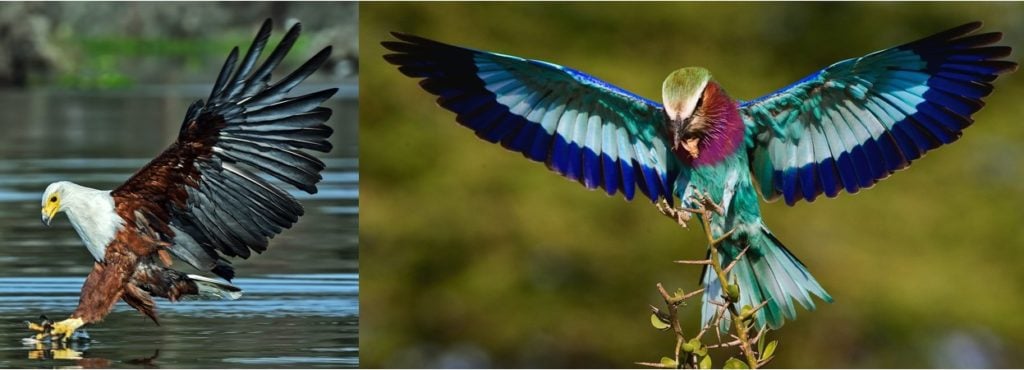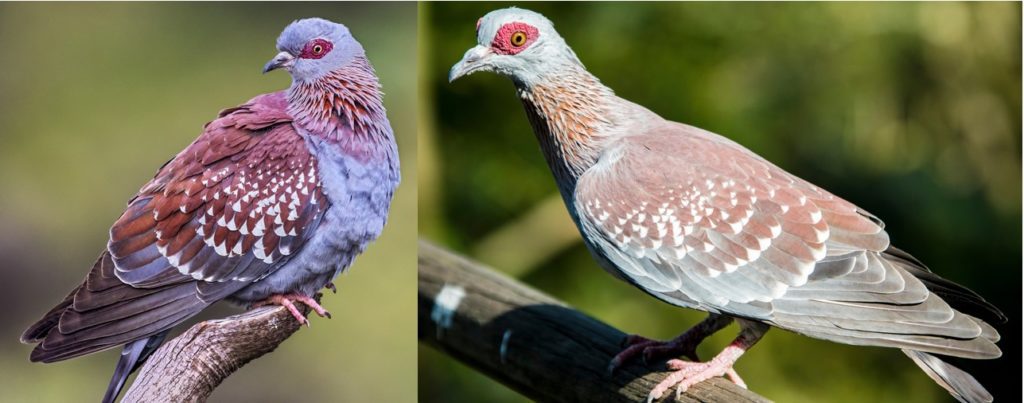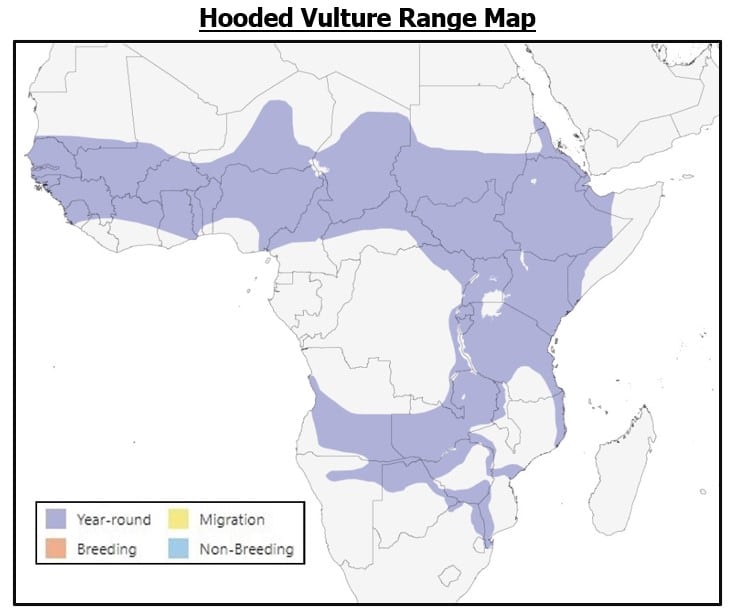10 COMMON Birds Found in Somalia! (2025)
Are you trying to identify a bird found in Somalia?

Some of the wildest and most colorful birds you could imagine are found here. From gigantic, flightless birds to colorful showstoppers, there’s something to catch everyone’s attention!
Due to the sheer number of species, there was no way to include every bird in Somalia in this article. So instead, I tried to focus on the birds that are most regularly seen and observed.
10 COMMON types of birds in Somalia!
#1. African Grey Hornbill
- Lophoceros nasutus

Identifying Characteristics:
- Adults are 45–51 cm (18–20 in) long.
- They are white, grey, and dusty brown. The wings have a scalloped pattern, and the dark grey head fades into white underparts.
- The beak is prominent, strong, and hooked downward.
The first thing you’ll notice about the African Grey Hornbill is its large beak. They look somewhat top-heavy, but the bill has internal supports and hollow chambers that keep it fairly light. Nevertheless, its top two neck vertebrae are fused, probably for additional support.
African Grey Hornbills have the most unusual breeding habits of any bird in Somalia!
The mother sheds all her flight feathers just before nesting time in preparation for the coming months. Then, the female encloses herself and the eggs inside with mud, poop, and fruit purée! The male brings food to the incubating mother and passes it through a tiny hole in the chamber wall. While she is incubating the eggs, she regrows her flight feathers.
Once the nestlings outgrow the hollow, she breaks out, reseals it, and then both parents feed the young through the small hole that remains. They probably deserve an award for their dedication to making more little African Grey Hornbills!
#2. African Sacred Ibis
- Threskiornis aethiopicus

Identifying Characteristics:
- Adults are 68 cm (27 in) long with a wingspan of 112-124 cm (44-49 in).
- Their plumage is white overall, with black wing tips and tail feathers.
- The head and legs are black and featherless, and the beak is very long and curved downward.
The Sacred Ibis was integral to ancient Egyptian religious ceremonies. Unfortunately, it’s now locally extinct in Egypt. However, it is still widespread in Somalia.
Its long scythe-like beak cuts through vegetation in marshes, swamps, and along riverbanks. It pokes in the muddy bottoms of small water bodies as it forages and visits mud flats far inland in search of food. You may even see them in garbage dumps, pasturelands, and freshly plowed fields, looking for earthworms.
The African Sacred Ibis has a variety of sounds, from a call similar to a yappy dog to a long, loud honk. This call, a long chirping noise, is one of their most common.

#3. Hooded Vulture
- Necrosyrtes monachus

Identifying Characteristics:
- Adults are 62–72 cm (24–28 in) long with a wingspan of 155–180 cm (61–71 in).
- Their plumage is a uniform brown, with a featherless pinkish-white face and a grey-brown “hood” of short feathers.
- This large vulture has an upright posture, large body, and small head, which are typical of its kind.
The Hooded Vulture is more mild-mannered than most other scavengers in Somalia.
As a result, it’s developed skills to make sure they can eat before more aggressive vultures chase it off from a carcass. It often arrives first, takes a small meal, and moves on, eating more frequently and in smaller portions.
Another way this species has adapted is to start visiting slaughterhouses and garbage dumps. Here, they take advantage of easy meals. The clever part is that the bigger, more aggressive vultures are not comfortable around humans, so Hooded Vultures avoid conflict.
Despite finding ways to adapt and survive, Hooded Vultures are still considered critically endangered. Often, when poachers kill big game, they remove the valuable parts and then poison the carcass with pesticides. These toxins kill any vultures that come to feed, so rangers won’t see vultures circling the carcasses, and the criminals have more time to get away.
#4. Lilac-Breasted Roller
- Coracias caudatus

Identifying Characteristics:
- Adults are 36-38 cm (14-15 in) long, with a wingspan of 50-58 cm (19-23 in).
- The coloring of this species is lilac on the chest with bright teal and royal blue on the head, body, and wings.
- This species’ head is large for its body.
The Lilac-breasted Roller has an aggressive attitude, particularly when defending its nest. It will ascend 144 meters (472 feet) to dive bomb much larger raptors. And it will juke and roll to attack other intruders.
They are primarily insectivores, but they also eat scorpions, snails, lizards, rodents, and even other birds. They use their wings to batter prey into submission, then eat it whole.
Lilac-breasted Rollers make a remarkably loud and frightening sound as it plummets from the sky to attack.

#5. Little Bee-Eater
- Merops pusillus

Identifying Characteristics:
- Adults are 15–17 cm (6-7 in.) long.
- They have a green back, a bright yellow throat, and a black collar. Their bellies are a deeper brownish-yellow.
- This species is slender and upright, with a pointed black beak.
Little Bee-eaters are the smallest species of African bee-eater. These birds are quite tame and friendly. They make practically no sound except for a quietly trilled “s-s-e-e-e-p.”
As their name implies, these little birds subsist on hornets, wasps, and bees. But, they’ve found an efficient way to avoid being stung by their favorite foods. Before they eat them, they smash their prey’s stinger into a hard surface several times to extract it.
Look for groups of Little Bee-eaters lined up, roosting communally on a branch. These tight-knit communities spend time together year-round. For example, a non-breeding pair will help feed chicks and even sit on the eggs to help out. Some nesters can have as many as five helpers raising the nestlings.
#6. Marabou Stork
- Leptoptilos crumenifer

Identifying Characteristics:
- Adults reach heights of 152 cm (5 feet) and have a wingspan of 3.7 m (12 ft).
- Its back and wings are black, with a white underside and bald, pinkish-white head and neck.
- This species is very large, with a pelican-like shape, huge bill, and long legs.
The Marabou Stork is the largest carrion bird in Somalia!
This gigantic species stands taller than some adult humans and has an incredibly large wingspan.
Look for these birds, also called “Undertaker Birds”, circling above carcasses or garbage dumps. They fly with their neck retracted but keep their feet out, using them as a steering rudder. They occasionally take live prey, including flamingo chicks and crocodile hatchlings.
#7. Northern Red-Billed Hornbill
- Tockus erythrorhynchus

Identifying Characteristics:
- Adults are 50-60 cm (20-24 in) long.
- These black, white, and gray birds have large, bright red beaks.
- Their tails are long, and they are low to the ground when standing.
Look for Northern Red-billed Hornbills in dry forest habitats. They are ground foragers and omnivores, eating small animals, insects, fruits, and eggs. Although comfortable on the ground, they can also be seen soaring from tree to tree.
If this species looks familiar, it might be that you remember it from a movie! The Northern Red-billed Hornbill was the model for the character Zazu in The Lion King. I don’t think it takes much imagination to see the resemblance. 🙂
#8. Pied Crow
- Corvus albus

Identifying Characteristics:
- Adults are 46-52 cm (18-20 in) long.
- Their coloring is completely black, except for the stark white “vest” between their wings and across their chest.
If you’ve ever wondered about the difference between a crow and a raven, studying the Pied Crow is a good way to learn! This bird in Somalia is considered a “link” between the two related families. It has the larger bill and long legs of a raven, as well as wider wings and a longer tail. However, its beak is small and straight like a crow’s, and it also has the typical “caw” call.
Pied Crows are often found near humans, but they don’t interact with people very much. They seem to like villages and towns, probably because of the abundance of food due to human refuse.
They are social and may congregate near an abundance of food but are generally found in pairs or small groups. Pied Crows eat reptiles and mammals, nestlings and eggs, insects and invertebrates, peanuts, grains, carrion, and human trash. If there is a slaughterhouse in the vicinity, you’ll almost certainly find them there, too.
#9. Speckled Pigeon
- Columba guinea

Identifying Characteristics:
- Adults grow up to 41 cm (16 in) long.
- Their coloring is slate gray overall, with rusty wings and white tips on the flight feathers.
- They have a ring of red skin around the eye, giving them a wide-eyed look.
It’s not uncommon for hundreds of Speckled Pigeons to form a flock and inhabit the exterior of large human structures. They’re the primary food source for birds of prey that live in large cities.
Although their shape and behavior are similar to typical urban rock pigeons, Speckled Pigeons are much larger. This species is the largest pigeon in Somalia at nearly 41 cm (16 inches) long.
Even if the Speckled Pigeon’s call is understated and melodic, it can be overwhelming when hundreds are singing at once. It sounds like “OooOOOuu” repeated a dozen times or more in a row.

#10. Village Weaver
- Ploceus cucullatus

Identifying Characteristics:
- Adults are 15–17 cm (6-7 in) long.
- Males have a black face with a bright red eye, a bright yellow chest, a brown cowl down the back of the head, and splotchy black and yellow wings.
- Females are largely yellow (including the head), with pale olive stripes on the upper parts and buff-yellow chest and underparts.
The Village Weaver has some of the most interesting nesting habits of any bird in Somalia.
For one, the nests themselves look like Christmas ornaments! They’re woven balls of grass and feathers that hang from the branches of trees. Additionally, male Village Weavers build the nests alone and defend them to attract a mate. Think of this as showing off your big, new house to your date!
Once a female chooses a nest (and a mate), she fills it with bedding and lays her eggs. Then, the male finds another mate and begins the process again! Despite having up to five broods at a time, the male Village Weaver contributes to the feeding and care of all his hatchlings.
These communal birds can be quite noisy, as they spend most of their time in their nests calling to one another.

Do you need help identifying birds in Africa?
These books will provide you with much more information!
Which of these birds in Somalia have you seen before?
Leave a comment below!











